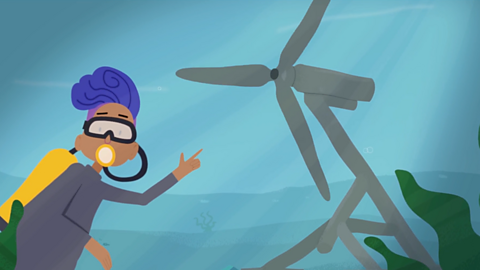What are natural resources?
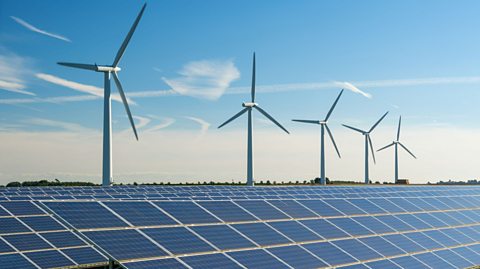
Natural resources are materials or substances that are produced by the environment.
Humans use natural resources to survive. They can be used to heat homes, transport people around the world, feed and clothe them.

What are agricultural resources?
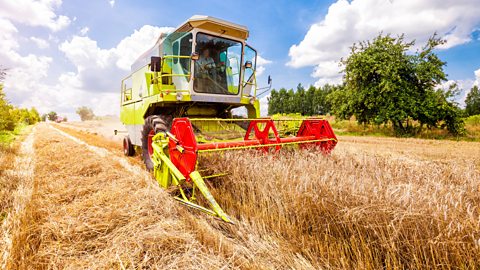
Agricultural resources are natural resources related to farming. These include:
- Crops, such as wheat and barley, vegetables and fruit
- Livestock such as cows, sheep, pigs and chickens, which produce dairy, eggs and meat
- Sheep, cows, pigs and goats, which produce wool and leather for clothes.
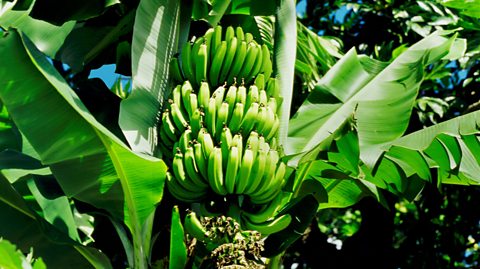
If agriculture is to succeed, you need good soils and enough water for irrigation. You also need insects like bees for pollination.
Countries around the world have different natural resources, depending on their location, their geology and climate.
Countries in tropical zones might grow things that can't be grown in the UK such as bananas or cocoa. This is because they have the right climate.
Some countries like Spain grow the same things as in the UK, such as tomatoes and lettuces. However, they can grow them all year round because the climate stays hot enough.

Watch: Natural resources
I’m stocking up on supplies. I need fuel, food and clothing and the UK is a good place to find all these things because it has a wide range of natural resources.
Natural resources are materials or substances that are produced by the environment, such as crops for food, oil for fuel or even wind, rivers and tides for generating electricity!
Our mild climate is good for growing crops like wheat and barley, as well as for raising livestock for meat and dairy produce.
Grassy hills are a habitat for sheep that provide wool for making fabrics.
These are called agricultural resources because they come from farms.
Resources found underground are called geological resources.
These include minerals like china clay, metals like tin and fossil fuels like gas and oil.
Fossil fuels were formed from the remains of plants and animals that died millions of years ago and we use them to power everything from cars and aeroplanes to gas cookers.
But nowadays we are using more power from renewable resources like wind and water instead.
Different countries have different natural resources.
South Africa has lots of gold and New Zealand has lots of sheep, Venezuela has lots of oil and Iceland has lots of fish and if I eat all these beans I’ll have lots of gas!
Farming in the UK
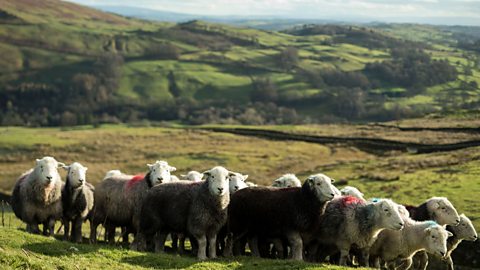
In the UK, there are three main types of farming:
- Arable is a type of farming where crops like wheat, barley, oil seed rape, oats, and potatoes are grown.
- Livestock involves the rearing of animals like sheep and cows.
- Mixed farming has both arable and livestock.
What is important for farming?
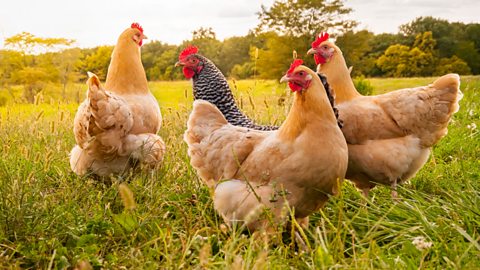
- Farmers rely on expected levels of temperature and rainfall for the crop being produced.
- Unusual weather events such as drought, flood or heatwaves can destroy crops and harm livestock.
- Oceans are home to a great variety of wildlife. This is called biodiversity, and it helps control the climate.
- The number of fish in the ocean is going down because of over-fishing. Some countries agree to only catch a certain amount of fish each year.

Watch: Food and farming
Farming is an important industry in the UK. There are many kinds of farming which harvest using natural resources. Some types of farming, like beekeeping, can be done in urban areas as well as rural ones.
Find out more by watching this video from BBC Teach.
De-Graft: Farming, or agriculture, is a massive industry in the UK. In fact, over 70% of land here is used for farming. And that ranges from growing crops, like vegetables and plants, to keeping animals big and small - like bees!
Farming is all about harvesting and using natural resources. And in this case it’s collecting honey from a bee hive.
Later locals Ethan and Aicha are going to be helping me plant some vegetables and learning a lot more about farming. But first, let’s zoom out.
We’re in Manchester, which is an urban environment. Farming typically happens in more rural environments across the UK. In places like County Antrim, Northern Ireland the rocky and hilly landscapes, which usually have less fertile soils, are best for farming livestock such as sheep. While in counties like Norfolk and Suffolk in the East of England there’s lots of flat and fertile land, which is good for growing crops like wheat.
Different regions are better suited for different types of farming because of the climate, soil, and topography (the shape of the land). There are three main types of farming: Arable farming, which means growing crops like vegetables and wheat. Pastoral farming, which means raising animals for things like meat, wool and dairy products. And mixed farming, which means growing crops and keeping animals.
In other countries farming can look quite different from farming in the UK, like growing rice in China or coffee farming in Central America.
Farming helps feed the population. Sometimes produce will be sold straight into shops or supermarkets, and sometimes crops will be processed or turned into something else first like potatoes into crisps, or wheat into flour. Intensive farming is when farming is done in a way to maximise the produce that is harvested, often by using fertilisers to boost the soil’s nutrients or pesticides to kill off insects that eat crops. Some people prefer organic farming, which means producing food without the use of chemicals.
I've met up with Manchester locals Ethan and Aicha to plant some vegetables at an urban rooftop farm.
So guys, when you walked in, what did you think of this place?
Aicha: I thought it was a bit nice because I’ve never seen a place like this before. I was thinking that it was pretty beautiful actually.
Ethan: Like a big huge garden, because of all the plants around here.
De-Graft: Yeah, it is like a big huge garden. And what are some of the things that you think could make farming a bit difficult?
Ethan: The rain because the soil can get all soggy.
Aicha: Finding the right places to dig.
De-Graft: Good suggestions guys. There are lots of factors that can affect farming such as the weather and soil type. Farming can involve using heavy machinery too, which can be hard work and costs a lot of money. But farming doesn’t have to be on massive plots of land with massive machines. But actually you have places like this called urban farms that you guys can get involved in.
Let’s hear from an expert. Jo is an urban farmer in Manchester – so what is an urban farm?
Jo: Urban farms allow people to support their local economy, to get in touch with their food and where it comes from and to shop seasonally. It’s all about growing produce in an environment, like a city centre, that is different to traditional countryside farming.
De-Graft: OK, time to compare… There are roughly 173,000 square kilometres of farmland in the UK – that's an area nearly the same size as the whole of Austria, Switzerland and Slovakia combined!
Where’s the nearest farm near you? And what does it look like? Zoom in and take a look for yourself.
Right guys, I think it’s time for us to finally water our plants. Let’s go!
Did you know?
- Agroforestry involves planting crops in between rows of trees to provide healthier soil, higher yields and homes for wildlife.
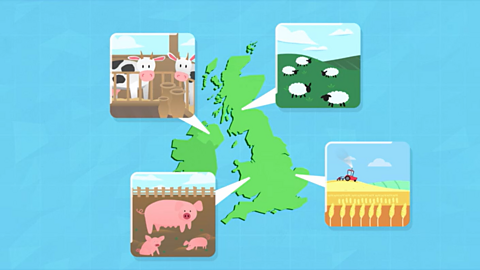
- Bananas are the staple food for millions of people around the world. They are grown both on small family farms and much larger commercial farms.
- The Windward Islands in the Caribbean earn around a fifth of their total export earnings from bananas alone.
Activities
Activity 1: Where is fruit grown?

Visit a local shop or supermarket and look carefully at the fresh fruit and vegetable section.
How many products can you identify that were made in the UK or in Britain?
Make a list and see if you can find out any more information about the exact location of the farm. Sometimes, labels give the names of the farms and their address.
Where else in the world are products grown? You could make a map to show where different foods are made.

Activity 2: Agricultural resources quiz
SATs preparation resources. activitySATs preparation resources
Get ready for the SATs papers with videos, activities, quizzes and games to refresh your knowledge and practise your skills.

More on Sustainability
Find out more by working through a topic
- count3 of 9
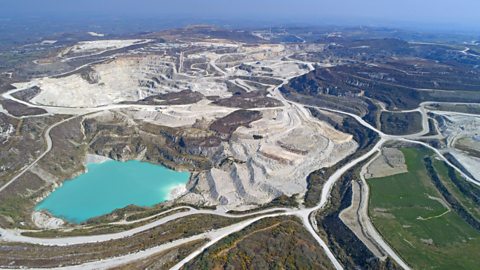
- count4 of 9
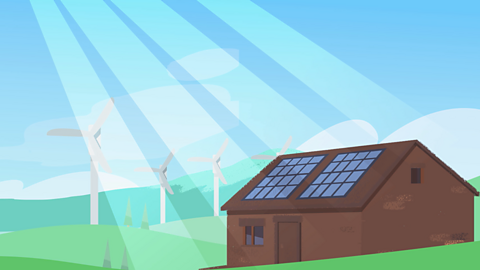
- count5 of 9
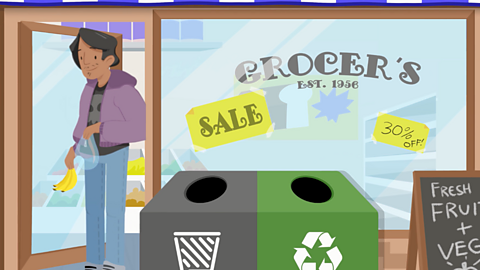
- count6 of 9
